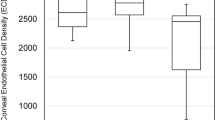Abstract
The purpose of this study is to evaluate anterior chamber aqueous flare (ACAF) in Tunisian patients with pseudoexfoliation (PEX) syndrome with or without associated glaucoma. This is a prospective, cross-sectional, comparative study including 53 patients (88 eyes) with PEX syndrome, 48 patients with PEX glaucoma (86 eyes), and 53 healthy sex-and age-matched control subjects (106 eyes). All patients underwent a complete ophthalmic examination and laser flare photometry. Mean ACAF was significantly higher in the PEX syndrome group in comparison with the control group (17.96 ± 10.05 vs 7.06 ± 2.95 ph/ms; p = 10−4), in patients with PEX glaucoma compared to PEX syndrome without associated glaucoma (27.99 ± 15.45 vs 17.96 ± 10.05 ph/ms; p = 10−4), in the PEX glaucoma group in comparison with control group (27.99 ± 15.45 vs 7.06 ± 2.95 ph/ms; p = 10−4), and in patients with unilateral PEX syndrome in comparison with contralateral-unaffected eyes (25.72 ± 14.88 vs 8.58 ± 3.45 ph/ms; p = 0.000). For patients with PEX syndrome, a high ACAF might be a predictor for the development of glaucoma. Further investigations are needed to clarify the role of laser flare photometry in predicting the risk of glaucoma in patients with PEX syndrome.
Similar content being viewed by others
References
Küchle M, Vinores SA, Mahlow J, Green WR (1996) Blood-aqueous barrier in pseudoexfoliation syndrome: evaluation by immunohistochemical staining of endogenous albumin. Graefes Arch Clin Exp Ophthalmol 234:12–18
Brooks AM, Gillies WE (1983) Fluorescein angiography and fluorophotometry of the iris in pseudoexfoliation of the lens capsule. Br J Ophthalmol 67:249–254
Tada H, Takahashi N, Kimura Y, Numaga T, Yoneya S (1988) Anterior segment fluorophotometry in pseudoexfoliation syndrome. Jpn J Clin Ophthalmol 42:698–699
Parodi MB, Liberali T, Iacono P, De Nicola M, Ballone E, Ravalico G (2008) The spectrum of iris angiography abnormalities in pseudoexfoliation syndrome. Eye 22:49–54
Küchle M, Nguyen NX, Horn F, Naumann GO (1992) Quantitative assessment of aqueous flare and aqueous ‘cells’ in pseudoexfoliation syndrome. Acta Ophthalmol (Copenh) 70:201–208
Küchle M, Nguyen NX, Hannappel E, Beck W, Ho ST, Naumann GO (1994) Tyndallometry with the laser flare cell meter and biochemical protein determination in the aqueous humor of eyes with pseudoexfoliation syndrome. Ophthalmologe 91(5):578–584
Küchle M, Nguyen NX, Hannappel E, Naumann GO (1995) The blood-aqueous barrier in eyes with pseudoexfoliation syndrome. Ophthalmic Res 27(Suppl1):136–142
Wang L, Yamasita R, Hommura S (1999) Corneal endothelial changes and aqueous flare intensity in pseudoexfoliation syndrome. Ophthalmologica 213:387–391
Ladas JG, Wheeler NC, Morhun PJ, Rimmer SO, Holland GN (2005) Laser flare-cell photometry: methodology and clinical applications. Surv Ophthalmol 50:27–47
Mori M, Araie M, Sakurai M, Oshika T (1992) Effects of pilocarpine and tropicamide on blood-aqueous barrier permeability in man. Invest Ophthalmol Vis Sci 33:416–423
Cellini M, Caramazza R, Bonsanto D, Bernabini B, Campos EC (2004) Prostaglandin analogs and blood-aqueous barrier integrity: a flare cell meter study. Ophthalmologica 218:312–317
Nguyen NX, Martus P, Küchle M (1996) A clinical comparative study of tyndallometry using 2 laser flare meters. Klin Monatsblatter Augenheilkd 209:89–93
Sein J, Galor A, Sheth A, Kruh J, Pasquale LR, Karp CL (2013) Exfoliation syndrome: new genetic and pathophysiologic insights. Curr Opin Ophthalmol 24:167–174
Dewundara S, Pasquale LR (2015) Exfoliation syndrome: a disease with an environmental component. Curr Opin Ophthalmol 26:78–81
Acknowledgments
This work has been supported by the Ministry of Higher Education and Research of Tunisia.
Author information
Authors and Affiliations
Corresponding author
Ethics declarations
Conflict of Interest
The authors declare that they have no conflict of interest.
Rights and permissions
About this article
Cite this article
Kahloun, R., Attia, S., Ksiaa, I. et al. Anterior chamber aqueous flare, pseudoexfoliation syndrome, and glaucoma. Int Ophthalmol 36, 671–674 (2016). https://doi.org/10.1007/s10792-016-0169-8
Received:
Accepted:
Published:
Issue Date:
DOI: https://doi.org/10.1007/s10792-016-0169-8




